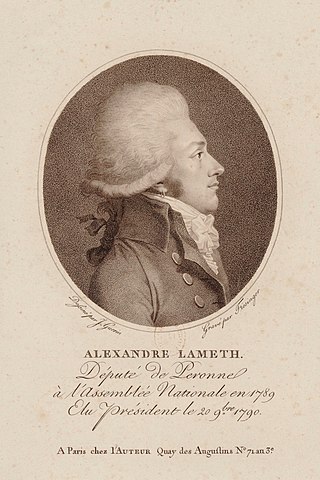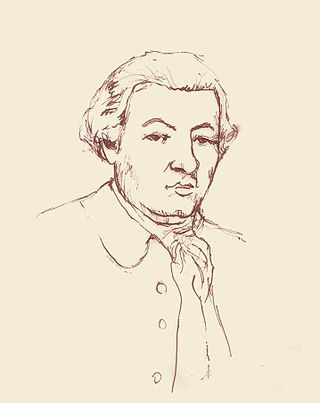
Alexandre-Théodore-Victor, comte de Lameth was a French soldier and politician.

Jean-Baptiste Louvet de Couvray was a French novelist, playwright and journalist.

Philibert, Count de Gramont (1621–1707), was a French courtier and soldier, known as the protagonist of the Mémoires written by Anthony Hamilton. He was a younger half-brother of Antoine III of Gramont and uncle of Catherine Charlotte de Gramont, princess of Monaco.

Jean-Baptiste Geneviève Marcellin Bory de Saint-Vincent was a French naturalist, officer and politician. He was born on 6 July 1778 in Agen (Lot-et-Garonne) and died on 22 December 1846 in Paris. Biologist and geographer, he was particularly interested in volcanology, systematics and botany. The standard author abbreviation Bory is used to indicate this person as the author when citing a botanical name.

Charles Théveneau de Morande was a gutter journalist, blackmailer and French spy who lived in London in the 18th century.

Guy Aldonce de Durfort, 1st Duke of Lorges, Marshal of France, (1630–1702) fought in the Franco-Dutch War mostly on the Rhine under his uncle Marshal Turenne, but in 1673 he was seconded to the Siege of Maastricht. Back on the Rhine, he fought at Entzheim in 1674, at Turckheim in January 1675, and at Sasbach in July 1675, where Turenne fell. He distinguished himself at the retreat from Sasbach and the ensuing Battle of Altenheim.

Philippe, Grand Prior of Vendôme (1655–1727) was a French general, a grand prior of France in the order of Malta, as well as an epicurian and a libertine.

Claude de Mesmes, comte d'Avaux (1595–1650) was a 17th-century French diplomat and public administrator. He was sent in various missions to Venice, Rome, Germany, Sweden, Denmark, and Poland by Richelieu.
Arthur Dillon, Count Dillon (1670–1733) was a Jacobite soldier from Ireland who served as colonel of Dillon's Regiment in the Irish Brigade in French service. He fought in the Nine Years' War and in the War of the Spanish Succession where he excelled at the Battle of Cremona against Prince Eugene of Savoy.

Charles-Marie Denys, comte de Damrémont was a French general and military governor of French Algeria. He was killed in combat during the siege of Constantine.

Conrad von Rosen was a soldier from Livonia, who served in the French army under Louis XIV from 1646 on. He fought in the Franco-Dutch War (1672–1678) and the Nine Years' War (1688–1691). In 1689, he went to Ireland with James II of England and commanded the Jacobite troops during the final stage of the unsuccessful Siege of Derry.

Antony Béraud, real name Antoine-Nicolas Béraud, was a French military, chansonnier, writer, poet, historian and playwright.
Louis-François L'Héritier, also known under the name L'Héritier de l'Ain was a 19th-century French playwright, essayist, novelist and journalist.

Ernest Hamel (1826-1898) was a French lawyer, poet, historian, journalist and politician. He served as a member of the French Senate from 1892 to 1898, representing Seine-et-Oise.

Jules-Joseph Guiffrey was a 19th-century French art historian, a member of the Académie des beaux-arts.

The Bastille or Bastille Saint-Antoine was completed in 1383. The commander of the Bastille was its governor, and was previously called capitaine.

Georges Lacour-Gayet was a French historian who taught at the École Navale and the École Polytechnique. His books on the French navy under Louis XV and Louis XVI are much-quoted and were considered references when published, although they betray his patriotic bias. His master work was a four-volume biography of Talleyrand.

Jean-Antoine de Mesmes, called d'Avaux (1640–1709), was a French diplomat in the service of Louis XIV. He is probably best known for accompanying King James II of England in his Irish expedition. He also negotiated for France the Peace of Nijmegen, which ended the Franco-Dutch War (1672–1678). He was French ambassador in Venice, The Hague, Stockholm and finally The Hague again.

Charles-Louis Du Pin was a French military man. He participated in the Second French intervention in Mexico, where he reorganized the local militia.
Pomponne de Refuge, full name: Alexandre Pomponne Eustache de Refuge, Marquis de Refuge, also referred to as the Marquis de Refuge, was a French official and military officer who played an important role in the France of king Louis XIV of France in the War of Devolution, the Franco-Dutch War, the Nine Years' War and the War of the Spanish Succession. He founded a military academy when he was governor of the Fortress of Charlemont. He ended his career as commander of the fortress of Metz and the surrounding area.

















